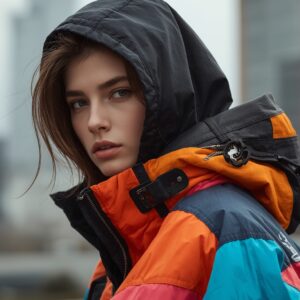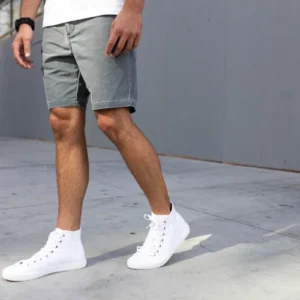Rain jackets are essential to any wardrobe, offering protection against the unpredictable weather each season brings. While they are primarily used to shield us from rain, not all jackets are created equal. Each season requires specific features and materials. Understanding this is key to making an informed purchase. In this guide, we’ll explore various options tailored for year-round wear.
A Jacket for Each Season
Spring: Lightweight and Breathable
A lightweight, breathable rain jacket is suitable as spring ushers in milder temperatures and occasional rain showers. Ventilation features like underarm zippers or mesh linings ensure comfort during mild, damp conditions. Water-resistant fabrics like nylon or polyester blend strike a balance between protection and breathability.
Summer: Packable and Ventilated
Warmer temperatures are expected during summer, making breathability a top priority. Go for a packable jacket easily stowed in a backpack or bag. Look for options with ventilation panels, back vents, or mesh linings to maximize airflow. Also, consider materials with moisture-wicking properties to stay comfortable in humid conditions.
Autumn: Versatility in Changing Weather
Cool, damp days and the occasional heavy downpour indicate autumn has rolled in. A versatile jacket with an adjustable hood and cuffs allows for customization depending on the weather. Water-resistant materials like polyester with a durable water repellent (DWR) finish protect against autumnal showers.
Winter: Insulated and Weatherproof
In winter, rain often accompanies the cold temperature. A poncho-like with added insulation or a removable liner retains warmth without sacrificing water resistance. Look for options with a higher waterproof rating (measured in millimeters) and sealed seams to withstand heavier rainfall. Consider a longer length for added protection.

Transitional Seasons: Layering Capability
Adaptability is required during transitional seasons like spring and autumn. Look for items with zip-out liners or those compatible with additional insulation layers. The versatility allows you to adjust to shifting temperatures and precipitation levels, ensuring you stay comfortable in any weather.
Additional Tips for Year-Round Rain Jacket Selection:
Examine Waterproof Ratings
Pay attention to the jacket’s waterproof rating, measured in millimeters (mm). A higher rating indicates better water resistance. For year-round wear, aim for a rating of at least 5,000mm to 10,000mm. This ensures reliable protection during drizzles or heavier downpours, regardless of the season.
Choose Breathability
Look for breathable fabrics or features like pit zips. A breathable jacket ensures moisture and heat can escape, preventing you from feeling clammy or overheated. A ventilated one, especially in warmer seasons, will keep you comfortable even when the temperature rises.
Consider Layering
For colder seasons, multiple clothing might be best. So, choose a rain jacket with room for layering underneath. It allows you to add insulation for warmth without sacrificing mobility. Look for parkas’ with adjustable cuffs and hems that accommodate additional layers comfortably.
Pay Attention to Seams
Taped seams are essential; remember that. It prevents water from seeping through the stitching. Look for jackets with sealed or taped seams for added protection. Through this, you’ll stay completely dry, even in heavy rain, as water won’t find its way through the seams.
Test the Fit
Great seasonal clothing allows for ease of movement, especially if you plan on layering. Test it with your usual layers to guarantee comfort. Consider activities you’ll be engaging in while wearing the jacket, and make sure it still allows the necessary range of motion.
Examine Hood Design and Adjustability
A well-designed and adjustable hood is invaluable for keeping your head dry. Look for ones with hoods that can be tightened securely around your face. Some types also have removable hoods, providing versatility based on weather conditions.
Pick Ones with Pockets
For convenience, consider the number and placement of pockets. They should be easily accessible, even when wearing a backpack or harness. Zippered pockets provide secure storage for essentials like a phone or wallet.
Ensure Reflective Elements for Visibility
For safety during low-light conditions, reflective elements on the coats are crucial. These can be strategically placed on the jacket to enhance visibility, so you’re seen by others, especially during evening walks or outdoor activities.
Reflect on Environmental Impact:
Choose a jacket made from eco-friendly materials. Some brands offer pieces constructed from recycled or sustainable fabrics. Additionally, look for options with a PFC-free DWR coating to minimize environmental impact.
A well-chosen rain jacket is your steadfast companion, ready to shield you from the elements year-round. Selecting one tailored to each season’s unique demands ensures that comfort and protection are always at your fingertips. With breathable fabrics, adjustable hoods, and taped seams, you can confidently face whatever weather comes your way.
However, a great jacket offers more than just practicality. It’s a statement of your readiness to embrace adventure, no matter the forecast. The right piece lets you explore new trails, stroll through autumn mists, or enjoy a spring shower without missing a beat. It’s an investment in your comfort, style, and the freedom to revel in the beauty of each season.





